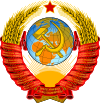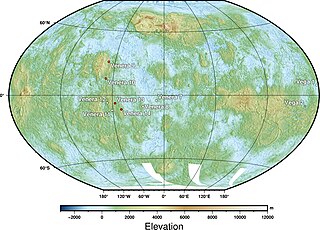
The Venera program was the name given to a series of space probes developed by the Soviet Union between 1961 and 1984 to gather information about the planet Venus.
Tyazhely Sputnik, also known by its development name as Venera 1VA No. 1, and in the West as Sputnik 7, was a Soviet spacecraft, which was intended to be the first spacecraft to explore Venus. Due to a problem with its upper stage it failed to leave low Earth orbit. In order to avoid acknowledging the failure, the Soviet government instead announced that the entire spacecraft, including the upper stage, was a test of a "Heavy Satellite" which would serve as a launch platform for future missions. This resulted in the upper stage being considered a separate spacecraft, from which the probe was "launched", on several subsequent missions.
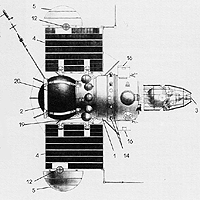
Venera 2MV-1 No.1, also known as Sputnik 19 in the West, was a Soviet spacecraft, which was launched in 1962 as part of the Venera programme.
Venera 2MV-1 No.2, also known as Sputnik 20 in the Western world, was a Soviet spacecraft, which was launched in 1962 as part of the Venera programme. Due to a problem with its upper stage it failed to leave low Earth orbit, and reentered the atmosphere a few days later. It was the second of two Venera 2MV-1 spacecraft, both of which failed to leave Earth orbit. The previous mission, Venera 2MV-1 No.1, was launched several days earlier.

Mars 1, also known as 1962 Beta Nu 1, Mars 2MV-4 and Sputnik 23, was an automatic interplanetary station launched in the direction of Mars on November 1, 1962, the first of the Soviet Mars probe program, with the intent of flying by the planet at a distance of about 11,000 km (6,800 mi). It was designed to image the surface and send back data on cosmic radiation, micrometeoroid impacts and Mars' magnetic field, radiation environment, atmospheric structure, and possible organic compounds.
Mars 2MV-3 No.1 also known as Sputnik 24 in the West, was a Soviet spacecraft, which was launched in 1962 as part of the Mars program, and was intended to land on the surface of Mars. Due to a problem with the rocket which launched it, it did not depart low Earth orbit, and it decayed several days later. It was the only Mars 2MV-3 spacecraft to be launched.
Kosmos 21 was a Soviet spacecraft. This mission has been tentatively identified by NASA as a technology test of the Venera series space probes. It may have been an attempted Venus impact, presumably similar to the later Kosmos 27 mission, or it may have been intended from the beginning to remain in geocentric orbit. In any case, the spacecraft never left Earth orbit after insertion by the Molniya launcher. The orbit decayed on 14 November 1963, three days after launch.

PAO S. P. Korolev Rocket and Space Corporation Energia, also known as RSC Energia, is a Russian manufacturer of spacecraft and space station components. The company is the prime developer and contractor of the Russian crewed spaceflight program; it also owns a majority of Sea Launch. Its name is derived from Sergei Korolev, the first chief of its design bureau, and the Russian word for energy.

Venera 3 was a Venera program space probe that was built and launched by the Soviet Union to explore the surface of Venus. It was launched on 16 November 1965 at 04:19 UTC from Baikonur, Kazakhstan, USSR. The probe comprised an entry probe, designed to enter the Venus atmosphere and parachute to the surface, and a carrier/flyby spacecraft, which carried the entry probe to Venus and also served as a communications relay for the entry probe.

Mars 1M was a series of two uncrewed spacecraft which were used in the first Soviet missions to explore Mars. They were the earliest missions of the Mars program. The Western media dubbed the spacecraft "Marsnik", a portmanteau of Mars and Sputnik.
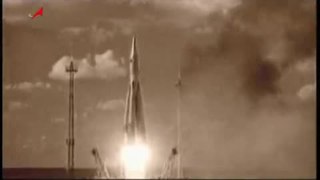
The Soviet space program was the national space program of the former Union of Soviet Socialist Republics (USSR), active from 1955 until the dissolution of the Soviet Union in 1991.
Venera 2MV-2 No.1, also known as Sputnik 21 in the West, was a Soviet spacecraft, which was launched in 1962 as part of the Venera programme, and was intended to make a flyby of Venus. Due to a problem with the rocket which launched it, it failed to leave low Earth orbit, and reentered the atmosphere a few days later. It was the second Venera 2MV-2 spacecraft, both of which failed to leave Earth orbit.

The 3MV planetary probe is a designation for a common design used by early Soviet unmanned probes to Mars and Venus. It was an incremental improvement of earlier 2MV probes and was used for Zond 1, Zond 2 and Zond 3 missions to Mars as well as several Venera probes. It was standard practice of the Soviet space program to use standardized components as much as possible. All probes shared the same general characteristics and differed usually in equipment necessary for specific missions. Each probe also incorporated improvements based on experience with earlier missions.
Kosmos 167, or 4V-1 No.311, was a 1967 Soviet spacecraft intended to explore Venus. A spacecraft launched as part of the Venera programme, Kosmos 167 was intended to land on Venus but never departed low Earth orbit due to a launch failure.
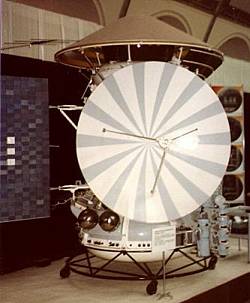
The 4MV planetary probe is a designation for a common design used for Soviet unmanned probes to Mars and Venus.
Kosmos 359 was an unmanned Soviet probe launched on 22 August 1970. The probe's intended purpose was to explore Venus, but an error caused the final-stage rocket to malfunction. This left the craft trapped in an elliptical orbit around Earth for 410 days before orbital decay and atmospheric entry. Kosmos 359 was launched five days after Venera 7 and had an identical design; had the craft not suffered a mission-ending failure, it would have landed on Venus shortly after Venera 7. To publicly acknowledge the failure of the attempted Venus lander would be a public relations disaster for the Soviet space program; after the mission failed, the Venera spacecraft was renamed Kosmos 359 in order to conceal the mishap from the public.

The 2MV planetary probe is a designation for a common design used by early Soviet uncrewed probes to Mars and Venus.

The Mars-69/M-69 or 2M was the designation given to 2 Soviet Mars probes that were to be sent in 1969. Based on the Luna E-8 landers used for Luna 15-24, they were the first attempted Mars and Interplanetary Orbiters. The probes, however, were both destroyed in separate launches in early 1969.











